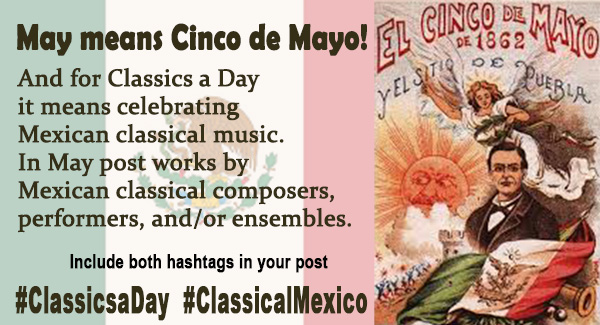#ClassicsaDay #ClassicalMexico Week 1
By Ralph Graves
The Classics a Day team decided to turn a holiday — Cinco de Mayo — into a month-long celebration. Mexico has a rich classical music tradition. It dates back to the early 1600s when Spanish — and very soon native-born — composers began writing music for church services. And today Mexico has a thriving classical music community. Even if we’re not aware of it here in the States.
Mexico has four centuries of classical music to choose from. Here are my selections for the first week of #ClassicalMexico.
05/01/23 Juan de Lienas (c. 1640): Lamentatio
De Lienas was a cacique (native of noble birth). His surviving sacred music is written in the high Renaissance style and was sung in the convent attached to the cathedral in Mexico City.
05/02/23 Francisco López Capillas (c. 1615 – 1673): Missa “Aufer a Nobis”
Capillas was born in Mexico City. He became the choirmaster of the Mexico City Cathedral in 1654 and is one of the most important native-born composers of Mexico.
05/03/23 Juan García de Zéspedes (c. 1619–1678): Hermoso amor que forxas
Zéspedes was born in Mexico and sang in the Puebla Cathedral choir under the direction of Juan Gutiérrez de Padilla. He eventually took over the position in 1664. Zéspedes wrote both sacred and secular compositions.
05/04/23 Manuel de Zumaya (1678–1755): Missa a 8 de tercer tono
Zumaya was born in Mexico and became chapelmaster at the Mexico City Cathedral in 1715. He was a priest, and his music blended high Renaissance and early Baroque sacred styles. Zumaya was the first native-born composer in the Americas to compose an opera.
05/05/23 José María Bustamante (1777–1861): El estopín
Bustamente was the chapel master at the Metropolitan Cathedral. He also taught at the first music conservatory in Latin America, founded in 1824. Bustamante was also a member of the Mexican independence movement, and wrote a heroic melodrama “Méjico libre.”


